Depression: Signs, Symptoms and Management Techniques
VerifiedAdded on 2023/04/25
|16
|1797
|291
Presentation
AI Summary
This educational tool aims to identify the knowledge gaps present among the youth, in relation to depression, its signs and symptoms, and effective management techniques. It acts as a crisis intervention for providing counselling services to teenagers and younger adults aged between 15-22 years. Depression is a prevalent mental disorder among the youth and adolescents that creates a negative impact on both physical and mental wellbeing. Lack of parental guidance and discrimination prevent the patients from accessing healthcare services. Psychotherapy, lifestyle changes, antidepressants, psychoanalysis, and web-based interventions are some of the evidence-based management techniques for depression.
Contribute Materials
Your contribution can guide someone’s learning journey. Share your
documents today.
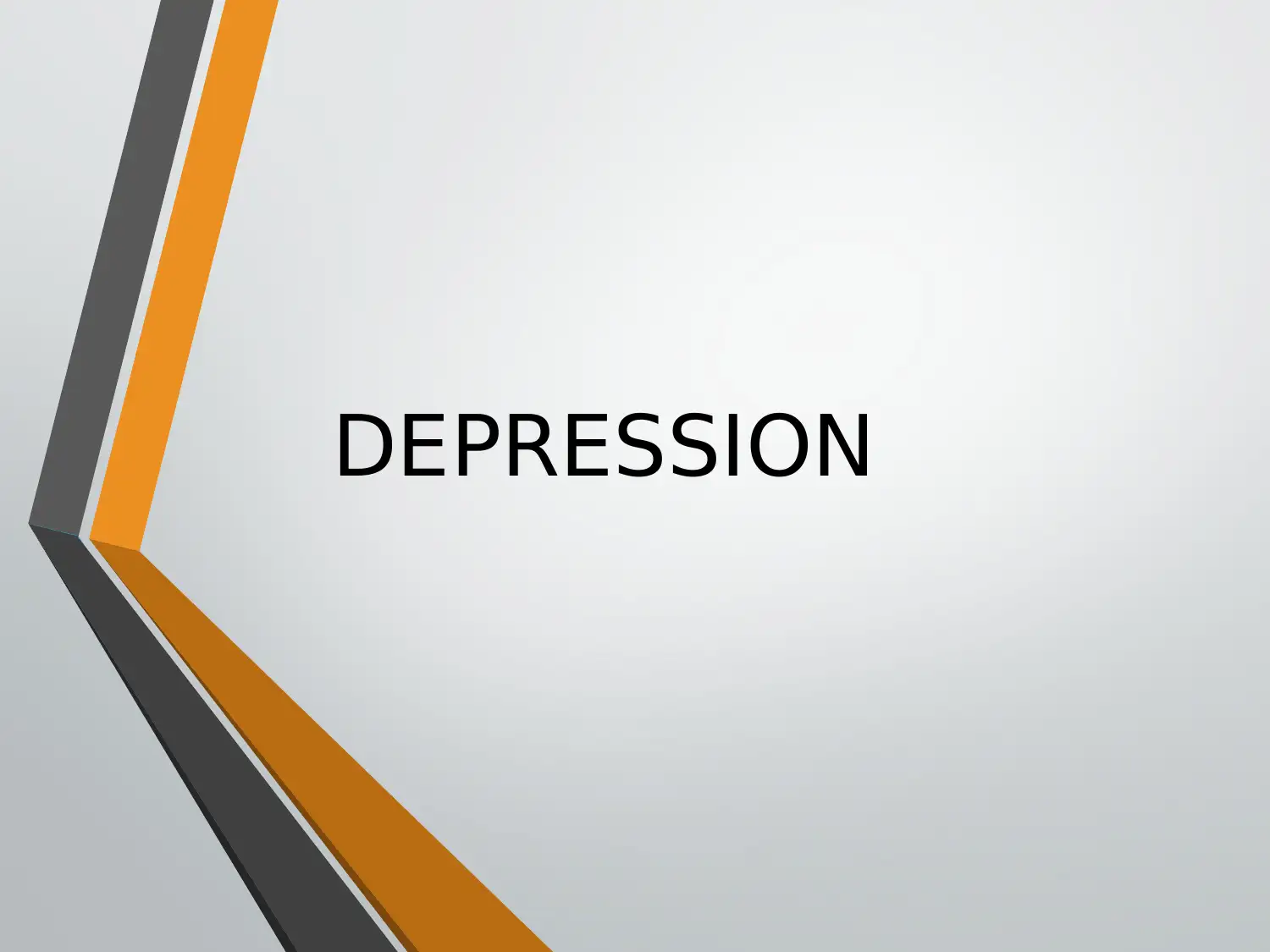
DEPRESSION
Secure Best Marks with AI Grader
Need help grading? Try our AI Grader for instant feedback on your assignments.
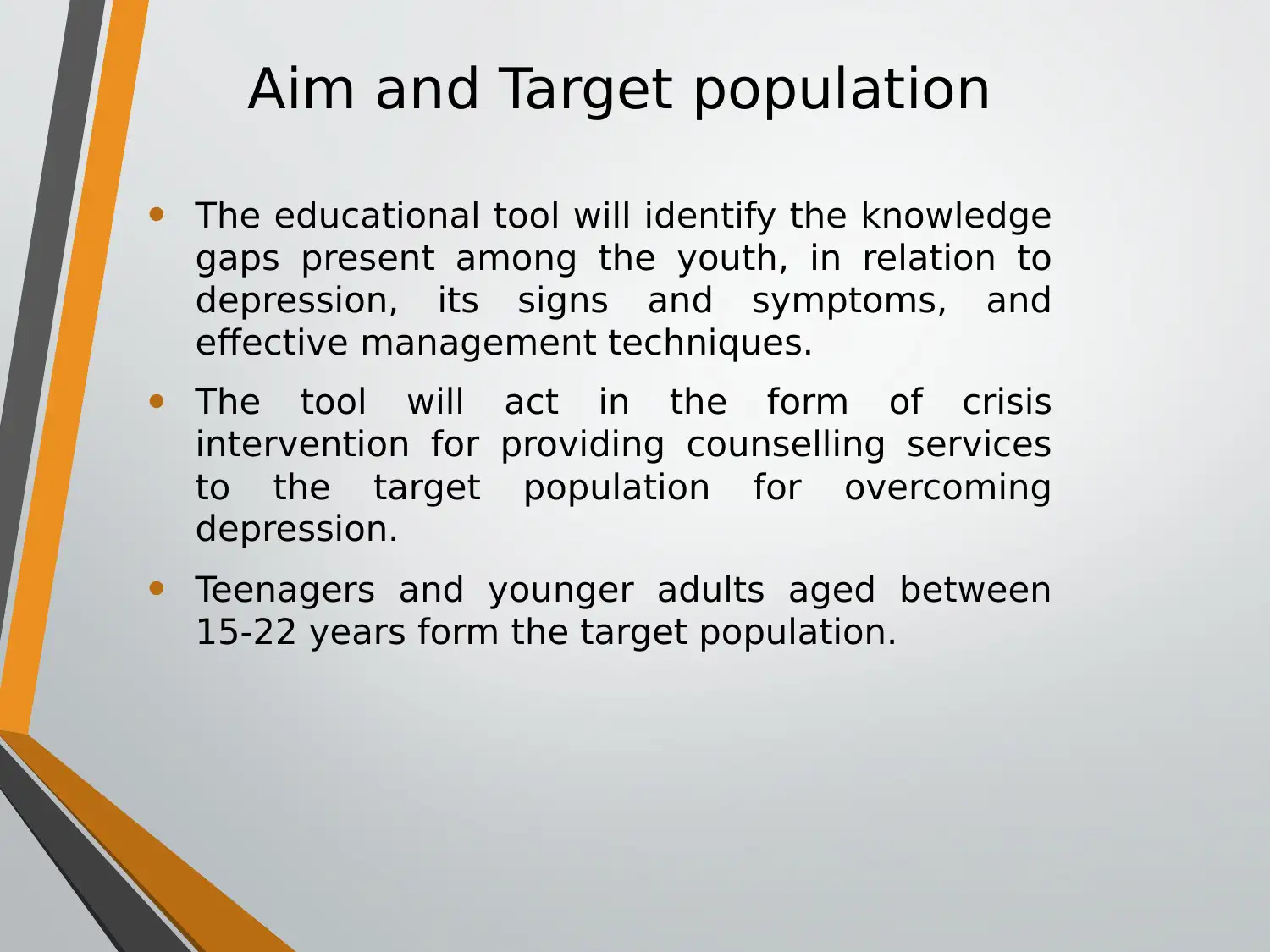
Aim and Target population
• The educational tool will identify the knowledge
gaps present among the youth, in relation to
depression, its signs and symptoms, and
effective management techniques.
• The tool will act in the form of crisis
intervention for providing counselling services
to the target population for overcoming
depression.
• Teenagers and younger adults aged between
15-22 years form the target population.
• The educational tool will identify the knowledge
gaps present among the youth, in relation to
depression, its signs and symptoms, and
effective management techniques.
• The tool will act in the form of crisis
intervention for providing counselling services
to the target population for overcoming
depression.
• Teenagers and younger adults aged between
15-22 years form the target population.
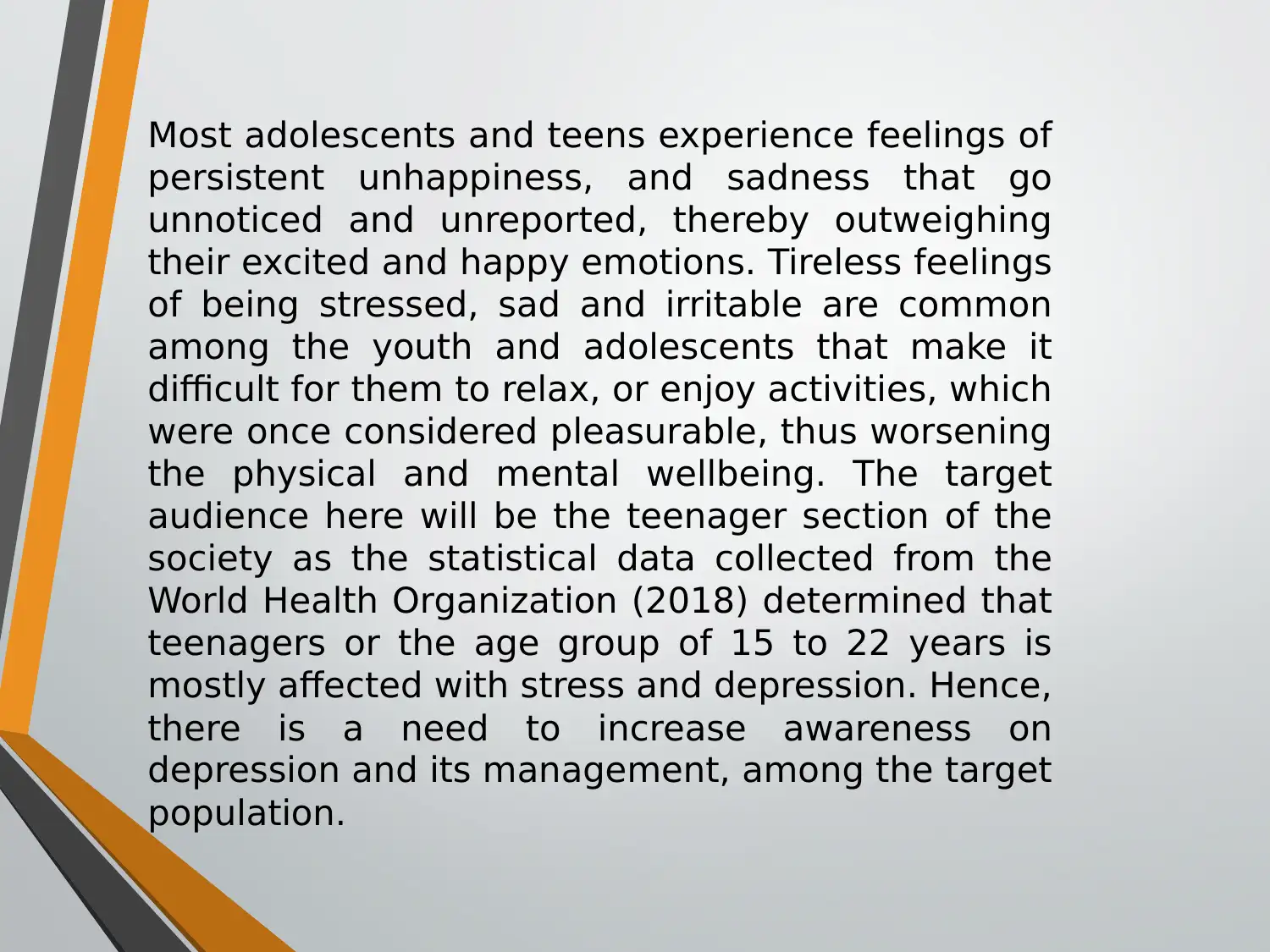
Most adolescents and teens experience feelings of
persistent unhappiness, and sadness that go
unnoticed and unreported, thereby outweighing
their excited and happy emotions. Tireless feelings
of being stressed, sad and irritable are common
among the youth and adolescents that make it
difficult for them to relax, or enjoy activities, which
were once considered pleasurable, thus worsening
the physical and mental wellbeing. The target
audience here will be the teenager section of the
society as the statistical data collected from the
World Health Organization (2018) determined that
teenagers or the age group of 15 to 22 years is
mostly affected with stress and depression. Hence,
there is a need to increase awareness on
depression and its management, among the target
population.
persistent unhappiness, and sadness that go
unnoticed and unreported, thereby outweighing
their excited and happy emotions. Tireless feelings
of being stressed, sad and irritable are common
among the youth and adolescents that make it
difficult for them to relax, or enjoy activities, which
were once considered pleasurable, thus worsening
the physical and mental wellbeing. The target
audience here will be the teenager section of the
society as the statistical data collected from the
World Health Organization (2018) determined that
teenagers or the age group of 15 to 22 years is
mostly affected with stress and depression. Hence,
there is a need to increase awareness on
depression and its management, among the target
population.
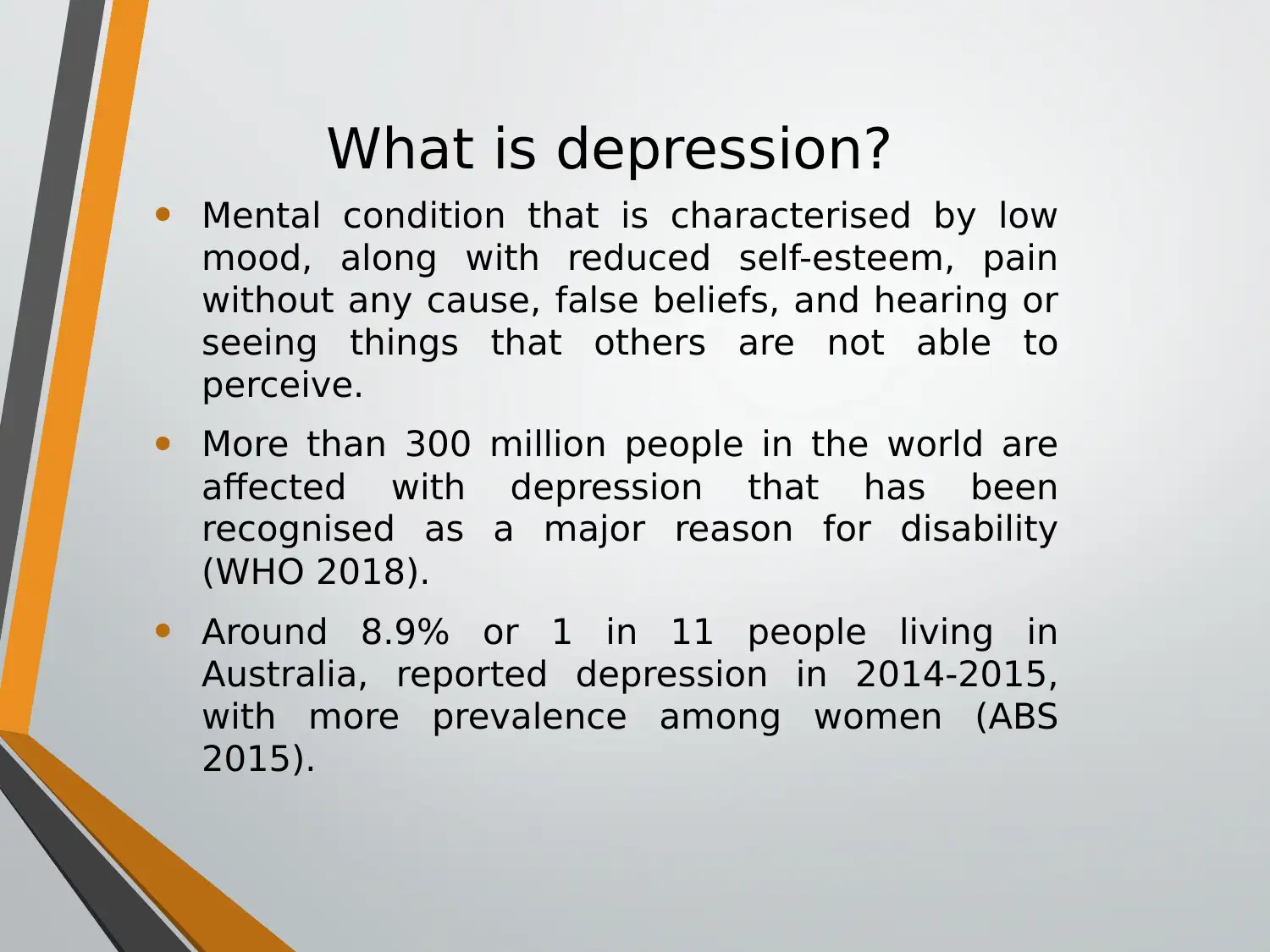
What is depression?
• Mental condition that is characterised by low
mood, along with reduced self-esteem, pain
without any cause, false beliefs, and hearing or
seeing things that others are not able to
perceive.
• More than 300 million people in the world are
affected with depression that has been
recognised as a major reason for disability
(WHO 2018).
• Around 8.9% or 1 in 11 people living in
Australia, reported depression in 2014-2015,
with more prevalence among women (ABS
2015).
• Mental condition that is characterised by low
mood, along with reduced self-esteem, pain
without any cause, false beliefs, and hearing or
seeing things that others are not able to
perceive.
• More than 300 million people in the world are
affected with depression that has been
recognised as a major reason for disability
(WHO 2018).
• Around 8.9% or 1 in 11 people living in
Australia, reported depression in 2014-2015,
with more prevalence among women (ABS
2015).
Secure Best Marks with AI Grader
Need help grading? Try our AI Grader for instant feedback on your assignments.
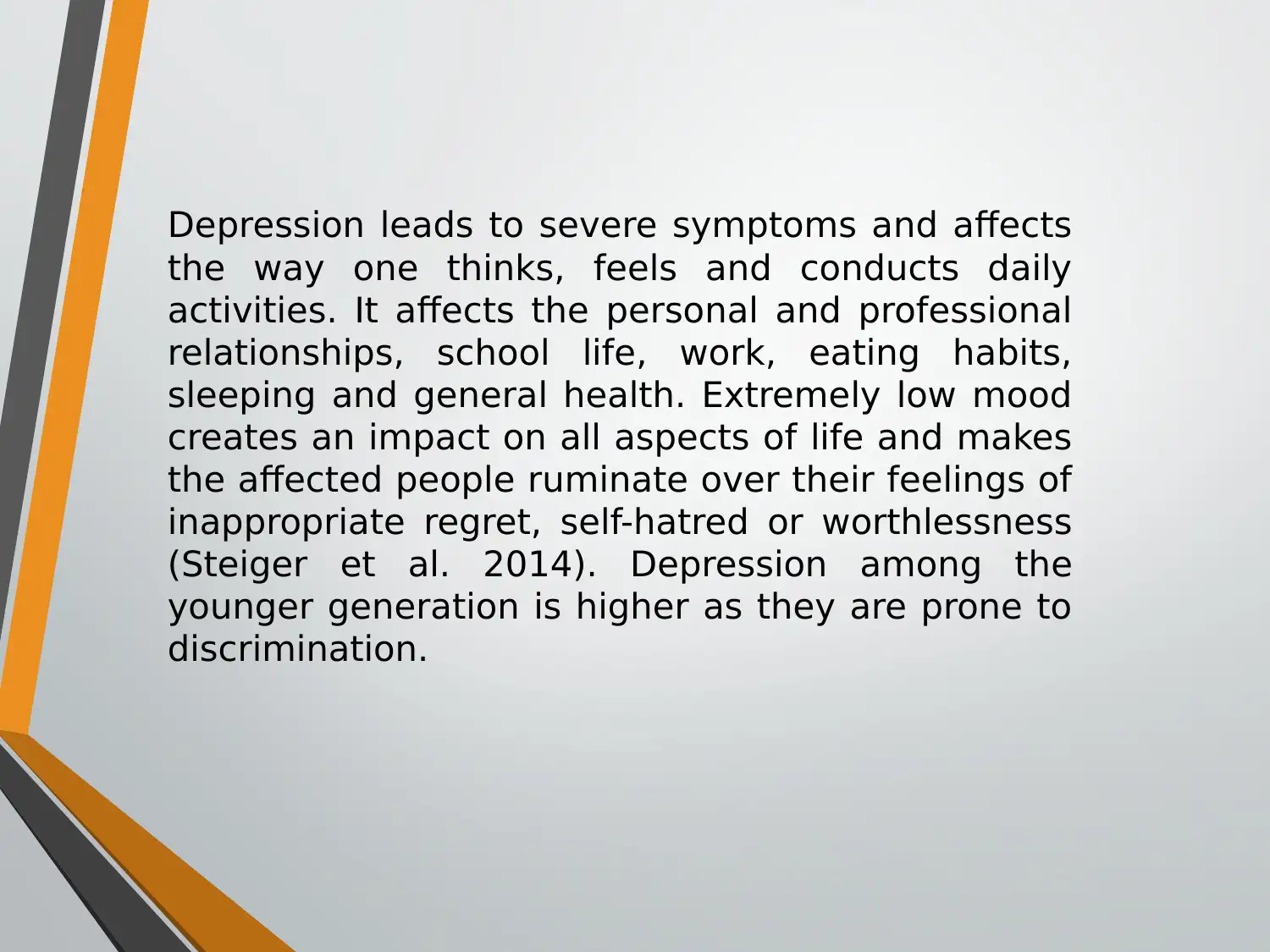
Depression leads to severe symptoms and affects
the way one thinks, feels and conducts daily
activities. It affects the personal and professional
relationships, school life, work, eating habits,
sleeping and general health. Extremely low mood
creates an impact on all aspects of life and makes
the affected people ruminate over their feelings of
inappropriate regret, self-hatred or worthlessness
(Steiger et al. 2014). Depression among the
younger generation is higher as they are prone to
discrimination.
the way one thinks, feels and conducts daily
activities. It affects the personal and professional
relationships, school life, work, eating habits,
sleeping and general health. Extremely low mood
creates an impact on all aspects of life and makes
the affected people ruminate over their feelings of
inappropriate regret, self-hatred or worthlessness
(Steiger et al. 2014). Depression among the
younger generation is higher as they are prone to
discrimination.
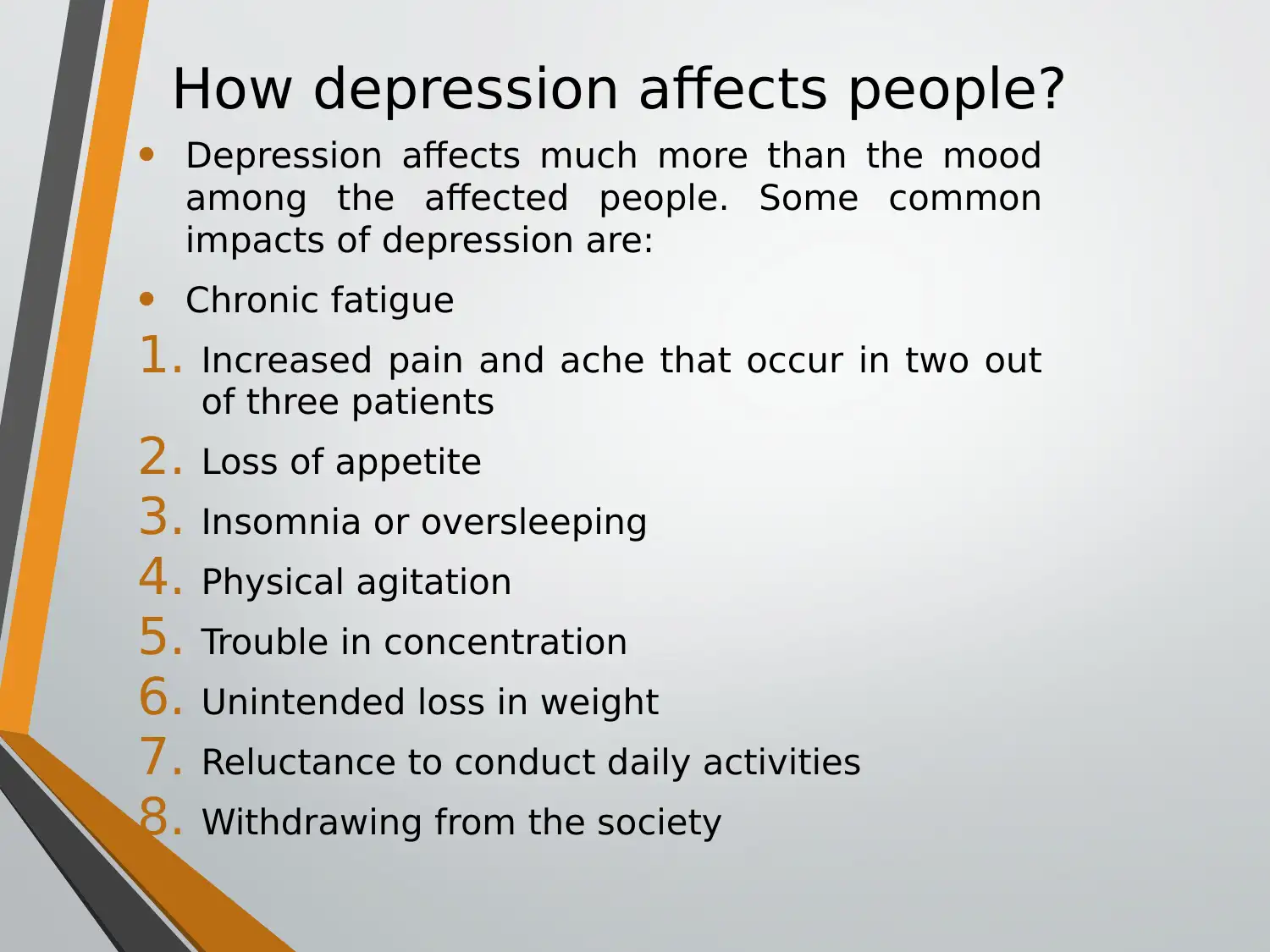
How depression affects people?
• Depression affects much more than the mood
among the affected people. Some common
impacts of depression are:
• Chronic fatigue
1. Increased pain and ache that occur in two out
of three patients
2. Loss of appetite
3. Insomnia or oversleeping
4. Physical agitation
5. Trouble in concentration
6. Unintended loss in weight
7. Reluctance to conduct daily activities
8. Withdrawing from the society
• Depression affects much more than the mood
among the affected people. Some common
impacts of depression are:
• Chronic fatigue
1. Increased pain and ache that occur in two out
of three patients
2. Loss of appetite
3. Insomnia or oversleeping
4. Physical agitation
5. Trouble in concentration
6. Unintended loss in weight
7. Reluctance to conduct daily activities
8. Withdrawing from the society
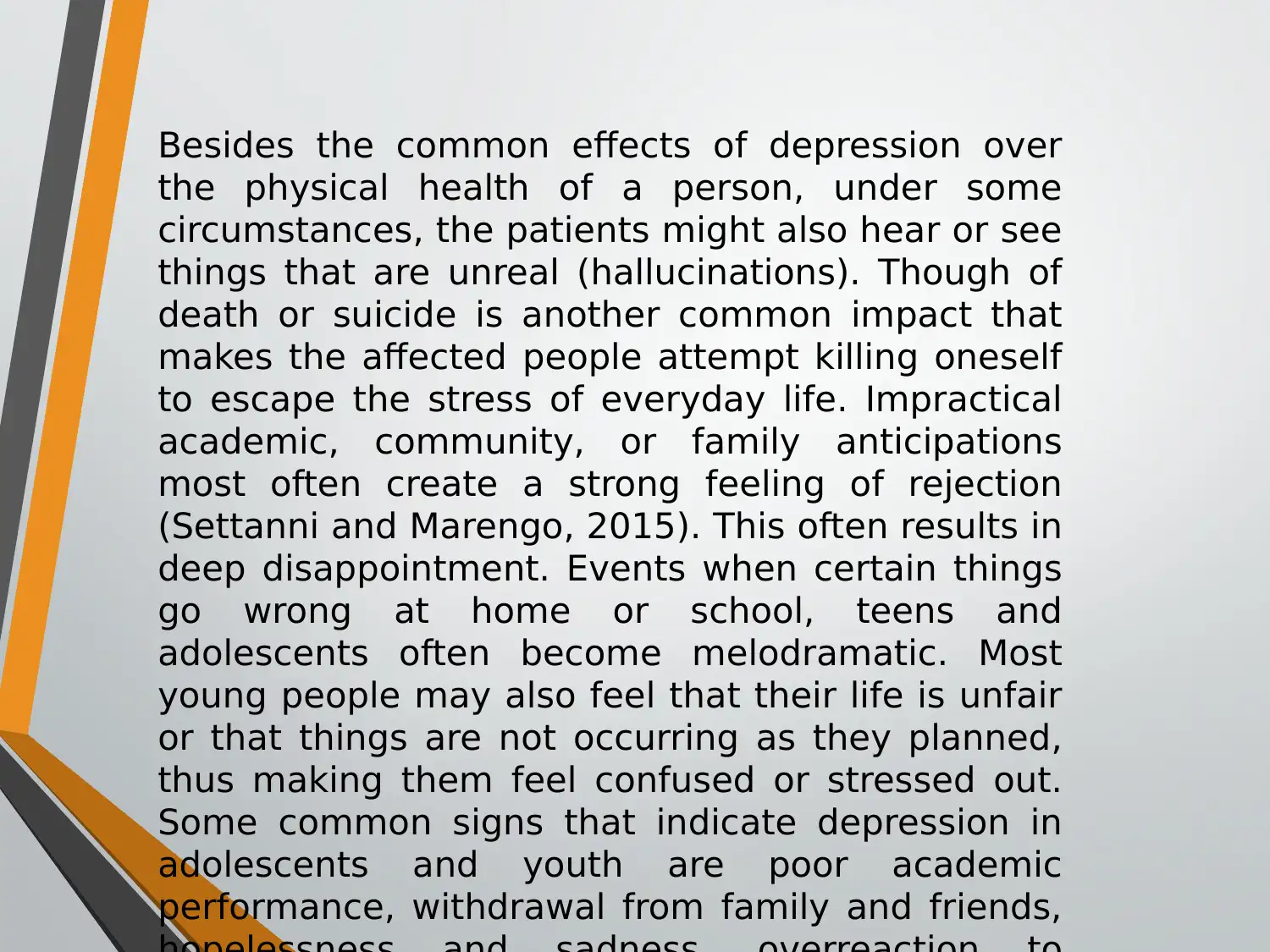
Besides the common effects of depression over
the physical health of a person, under some
circumstances, the patients might also hear or see
things that are unreal (hallucinations). Though of
death or suicide is another common impact that
makes the affected people attempt killing oneself
to escape the stress of everyday life. Impractical
academic, community, or family anticipations
most often create a strong feeling of rejection
(Settanni and Marengo, 2015). This often results in
deep disappointment. Events when certain things
go wrong at home or school, teens and
adolescents often become melodramatic. Most
young people may also feel that their life is unfair
or that things are not occurring as they planned,
thus making them feel confused or stressed out.
Some common signs that indicate depression in
adolescents and youth are poor academic
performance, withdrawal from family and friends,
the physical health of a person, under some
circumstances, the patients might also hear or see
things that are unreal (hallucinations). Though of
death or suicide is another common impact that
makes the affected people attempt killing oneself
to escape the stress of everyday life. Impractical
academic, community, or family anticipations
most often create a strong feeling of rejection
(Settanni and Marengo, 2015). This often results in
deep disappointment. Events when certain things
go wrong at home or school, teens and
adolescents often become melodramatic. Most
young people may also feel that their life is unfair
or that things are not occurring as they planned,
thus making them feel confused or stressed out.
Some common signs that indicate depression in
adolescents and youth are poor academic
performance, withdrawal from family and friends,
Paraphrase This Document
Need a fresh take? Get an instant paraphrase of this document with our AI Paraphraser

Educational gap
• A huge proportion of adolescents and youth
residing in the nation experience mental health
challenges each year
• A negligible proportion of the affected
population seeks treatment for mental health
services and benefits from the available
treatment facilities
• Feelings of recurrent emotional distress are
considered as low mood and not given much
importance
• Strong social stigma is associated with mental
health (Hatzenbuehler, Phelan and Link 2013)
• A huge proportion of adolescents and youth
residing in the nation experience mental health
challenges each year
• A negligible proportion of the affected
population seeks treatment for mental health
services and benefits from the available
treatment facilities
• Feelings of recurrent emotional distress are
considered as low mood and not given much
importance
• Strong social stigma is associated with mental
health (Hatzenbuehler, Phelan and Link 2013)
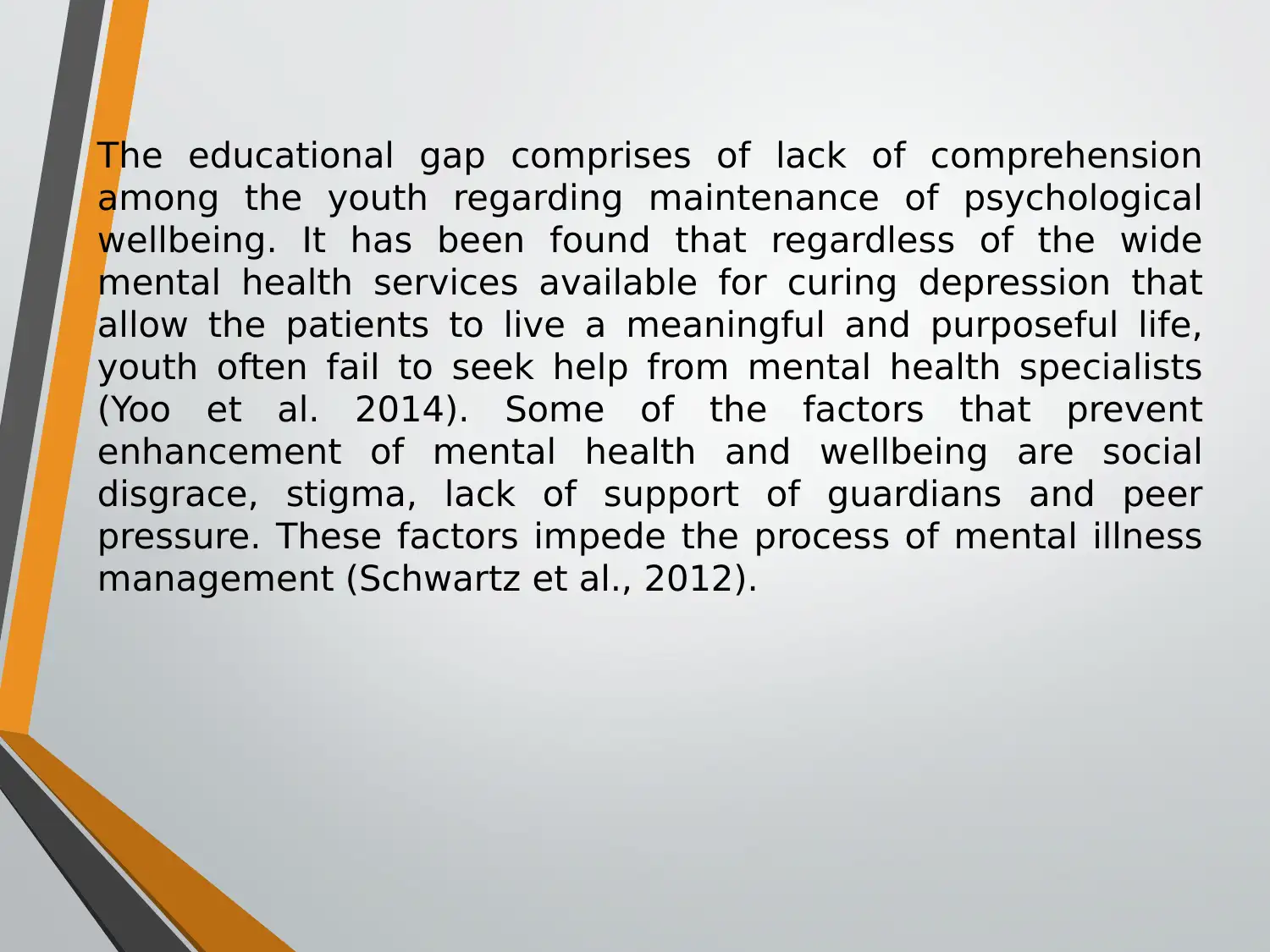
The educational gap comprises of lack of comprehension
among the youth regarding maintenance of psychological
wellbeing. It has been found that regardless of the wide
mental health services available for curing depression that
allow the patients to live a meaningful and purposeful life,
youth often fail to seek help from mental health specialists
(Yoo et al. 2014). Some of the factors that prevent
enhancement of mental health and wellbeing are social
disgrace, stigma, lack of support of guardians and peer
pressure. These factors impede the process of mental illness
management (Schwartz et al., 2012).
among the youth regarding maintenance of psychological
wellbeing. It has been found that regardless of the wide
mental health services available for curing depression that
allow the patients to live a meaningful and purposeful life,
youth often fail to seek help from mental health specialists
(Yoo et al. 2014). Some of the factors that prevent
enhancement of mental health and wellbeing are social
disgrace, stigma, lack of support of guardians and peer
pressure. These factors impede the process of mental illness
management (Schwartz et al., 2012).
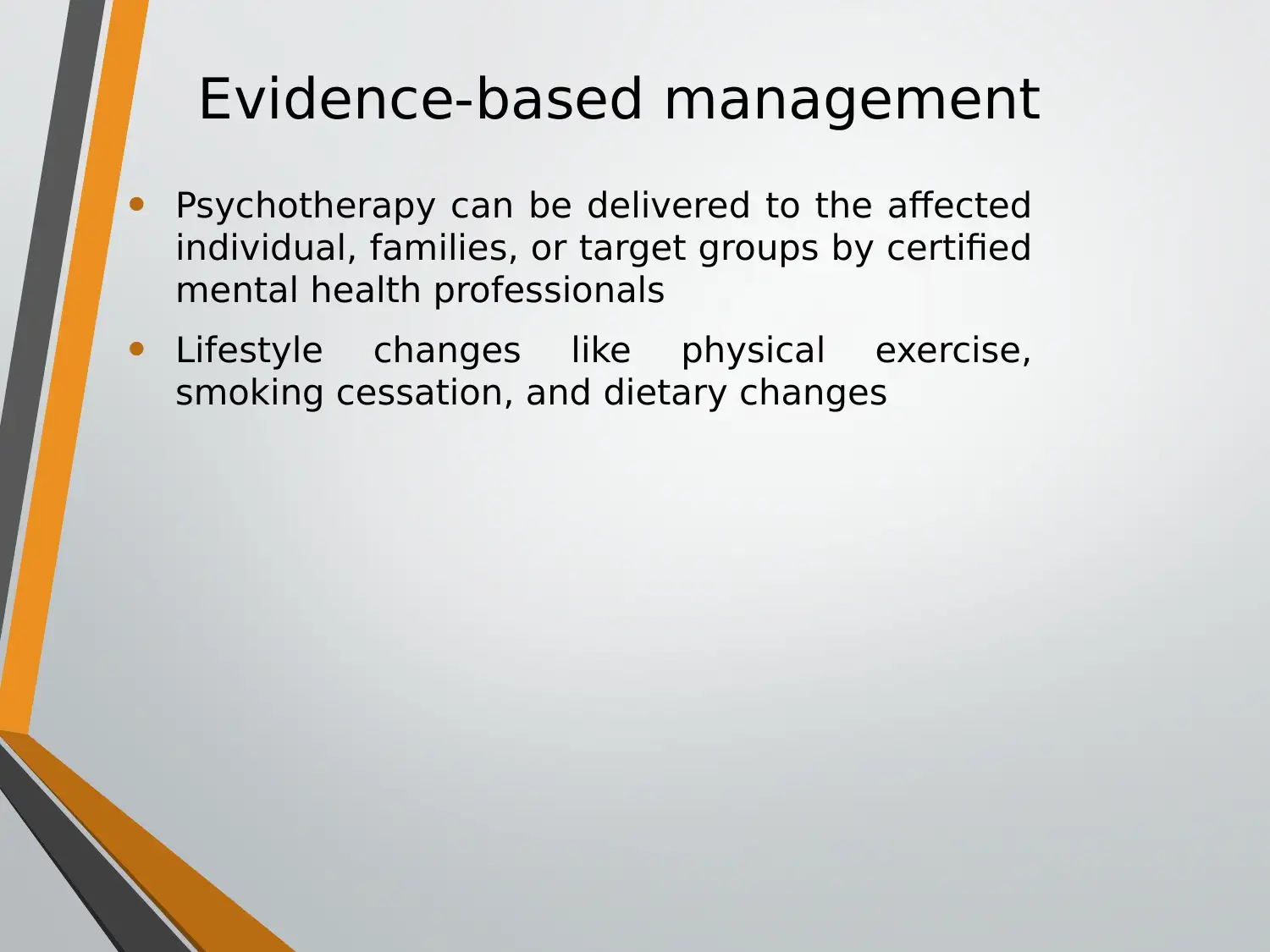
Evidence-based management
• Psychotherapy can be delivered to the affected
individual, families, or target groups by certified
mental health professionals
• Lifestyle changes like physical exercise,
smoking cessation, and dietary changes
• Psychotherapy can be delivered to the affected
individual, families, or target groups by certified
mental health professionals
• Lifestyle changes like physical exercise,
smoking cessation, and dietary changes
Secure Best Marks with AI Grader
Need help grading? Try our AI Grader for instant feedback on your assignments.

Psychotherapy treatment encompass personal
interaction and help the affected person to alter
the problematic behaviour, thus facilitating
overcoming the depression symptoms (Cuijpers et
al. 2014). This treatment strategy improves the
mental wellbeing of the depressed person, and
helps in resolving or mitigating compulsions,
thoughts, emotions, beliefs, thus improving social
skills and relationships. The sessions are typically
held once or twice a week, and last for not more
than one hour. Lifestyle changes are equivalent to
medications and decrease the severity of
depression, increase self-esteem, create
empowerment, enhance social connections, and
boost self-confidence. Healthy diet will promote
release of neurotransmitters (Taylor et al. 2014). In
addition, restorative sleep will alleviate
depression, by maintaining a balanced brain
interaction and help the affected person to alter
the problematic behaviour, thus facilitating
overcoming the depression symptoms (Cuijpers et
al. 2014). This treatment strategy improves the
mental wellbeing of the depressed person, and
helps in resolving or mitigating compulsions,
thoughts, emotions, beliefs, thus improving social
skills and relationships. The sessions are typically
held once or twice a week, and last for not more
than one hour. Lifestyle changes are equivalent to
medications and decrease the severity of
depression, increase self-esteem, create
empowerment, enhance social connections, and
boost self-confidence. Healthy diet will promote
release of neurotransmitters (Taylor et al. 2014). In
addition, restorative sleep will alleviate
depression, by maintaining a balanced brain
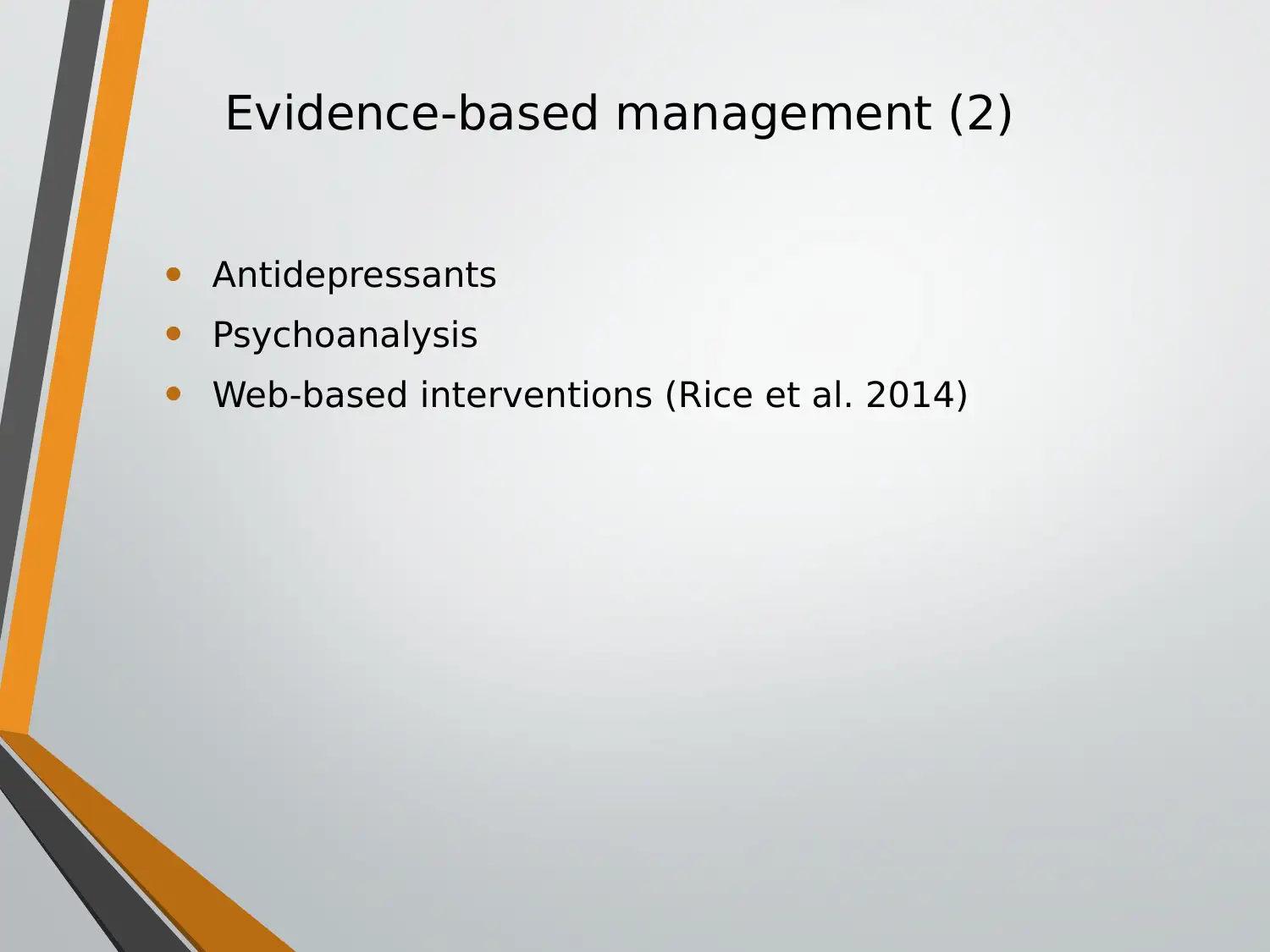
Evidence-based management (2)
• Antidepressants
• Psychoanalysis
• Web-based interventions (Rice et al. 2014)
• Antidepressants
• Psychoanalysis
• Web-based interventions (Rice et al. 2014)
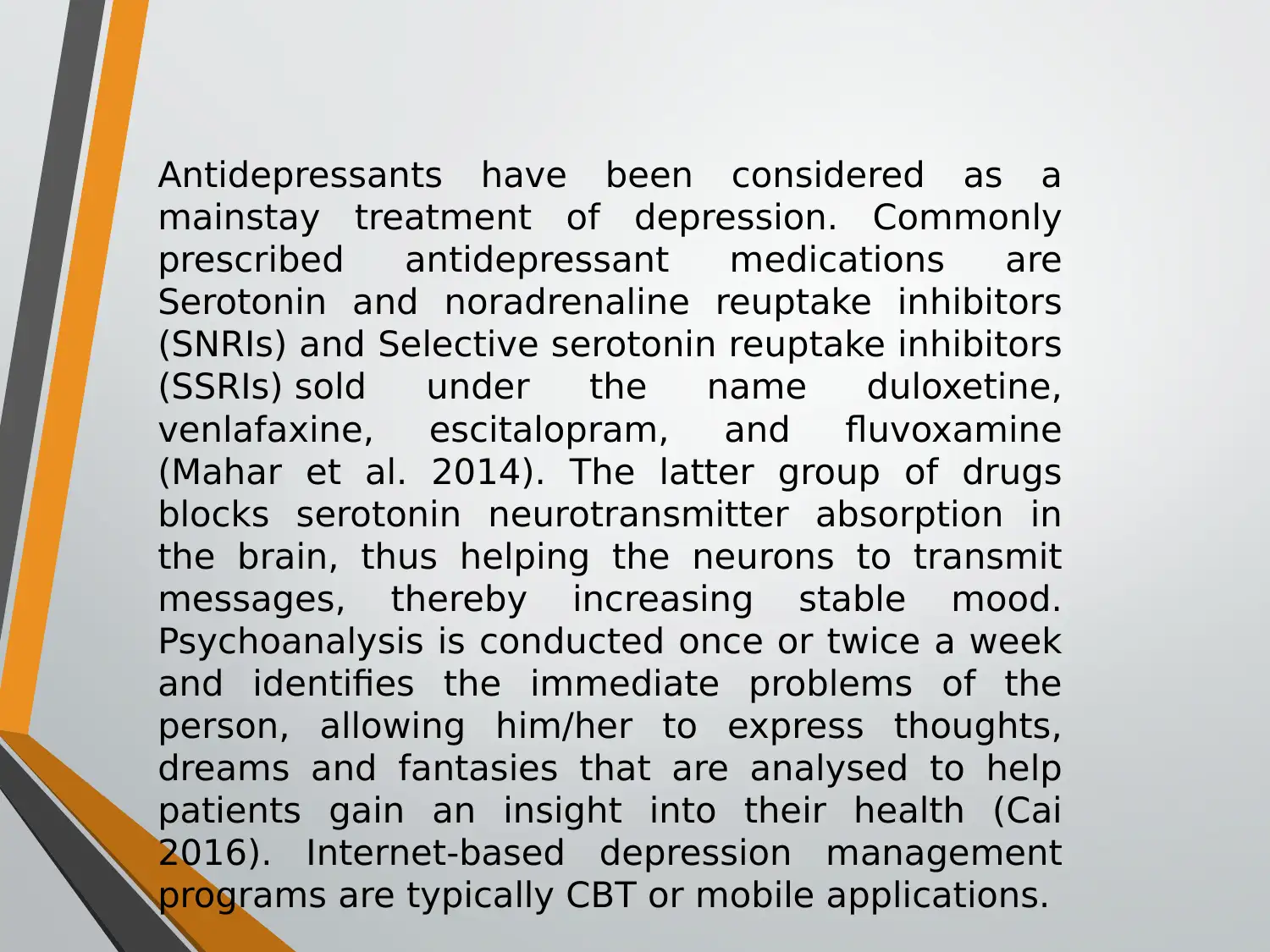
Antidepressants have been considered as a
mainstay treatment of depression. Commonly
prescribed antidepressant medications are
Serotonin and noradrenaline reuptake inhibitors
(SNRIs) and Selective serotonin reuptake inhibitors
(SSRIs) sold under the name duloxetine,
venlafaxine, escitalopram, and fluvoxamine
(Mahar et al. 2014). The latter group of drugs
blocks serotonin neurotransmitter absorption in
the brain, thus helping the neurons to transmit
messages, thereby increasing stable mood.
Psychoanalysis is conducted once or twice a week
and identifies the immediate problems of the
person, allowing him/her to express thoughts,
dreams and fantasies that are analysed to help
patients gain an insight into their health (Cai
2016). Internet-based depression management
programs are typically CBT or mobile applications.
mainstay treatment of depression. Commonly
prescribed antidepressant medications are
Serotonin and noradrenaline reuptake inhibitors
(SNRIs) and Selective serotonin reuptake inhibitors
(SSRIs) sold under the name duloxetine,
venlafaxine, escitalopram, and fluvoxamine
(Mahar et al. 2014). The latter group of drugs
blocks serotonin neurotransmitter absorption in
the brain, thus helping the neurons to transmit
messages, thereby increasing stable mood.
Psychoanalysis is conducted once or twice a week
and identifies the immediate problems of the
person, allowing him/her to express thoughts,
dreams and fantasies that are analysed to help
patients gain an insight into their health (Cai
2016). Internet-based depression management
programs are typically CBT or mobile applications.
Paraphrase This Document
Need a fresh take? Get an instant paraphrase of this document with our AI Paraphraser
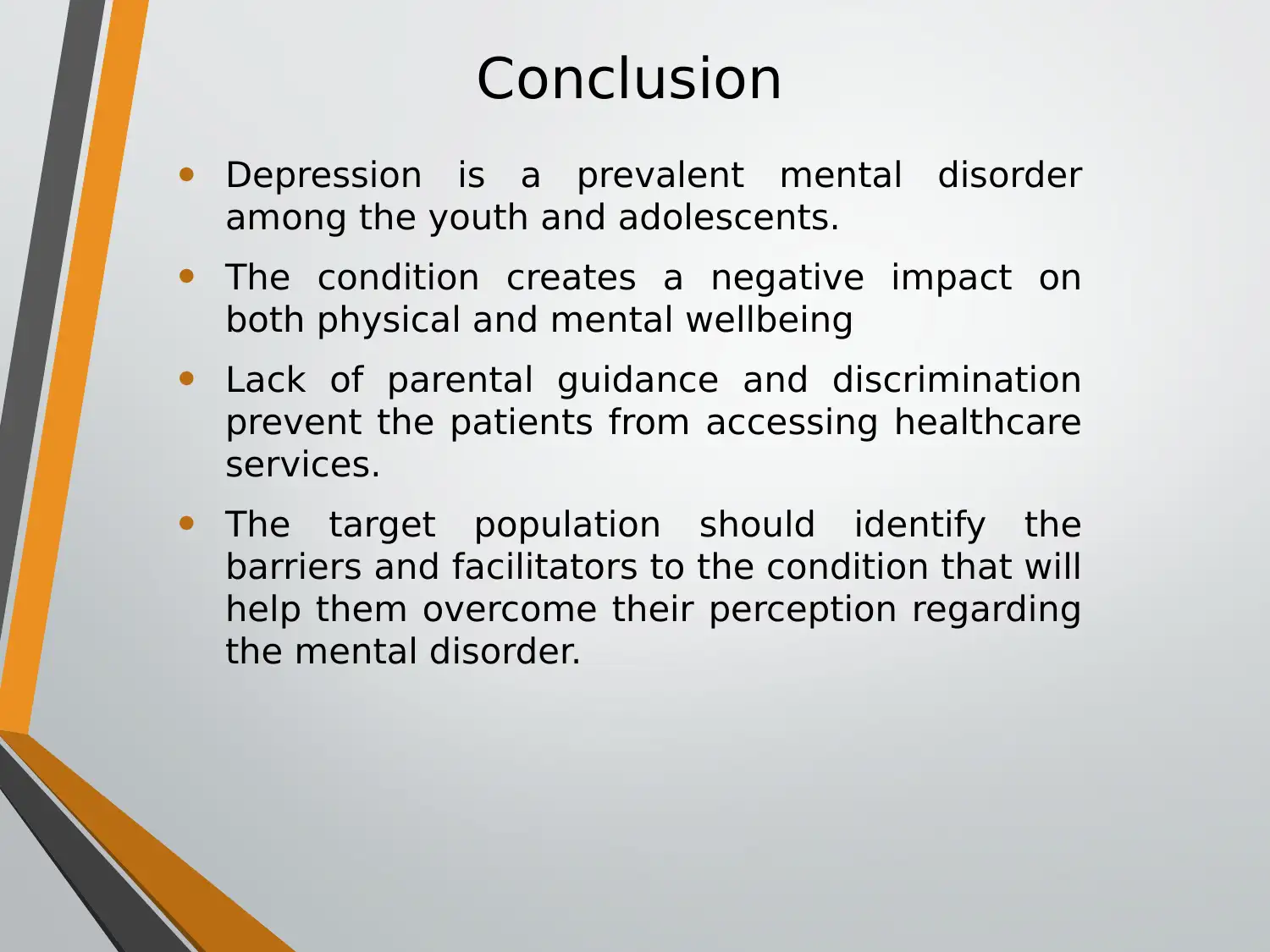
Conclusion
• Depression is a prevalent mental disorder
among the youth and adolescents.
• The condition creates a negative impact on
both physical and mental wellbeing
• Lack of parental guidance and discrimination
prevent the patients from accessing healthcare
services.
• The target population should identify the
barriers and facilitators to the condition that will
help them overcome their perception regarding
the mental disorder.
• Depression is a prevalent mental disorder
among the youth and adolescents.
• The condition creates a negative impact on
both physical and mental wellbeing
• Lack of parental guidance and discrimination
prevent the patients from accessing healthcare
services.
• The target population should identify the
barriers and facilitators to the condition that will
help them overcome their perception regarding
the mental disorder.
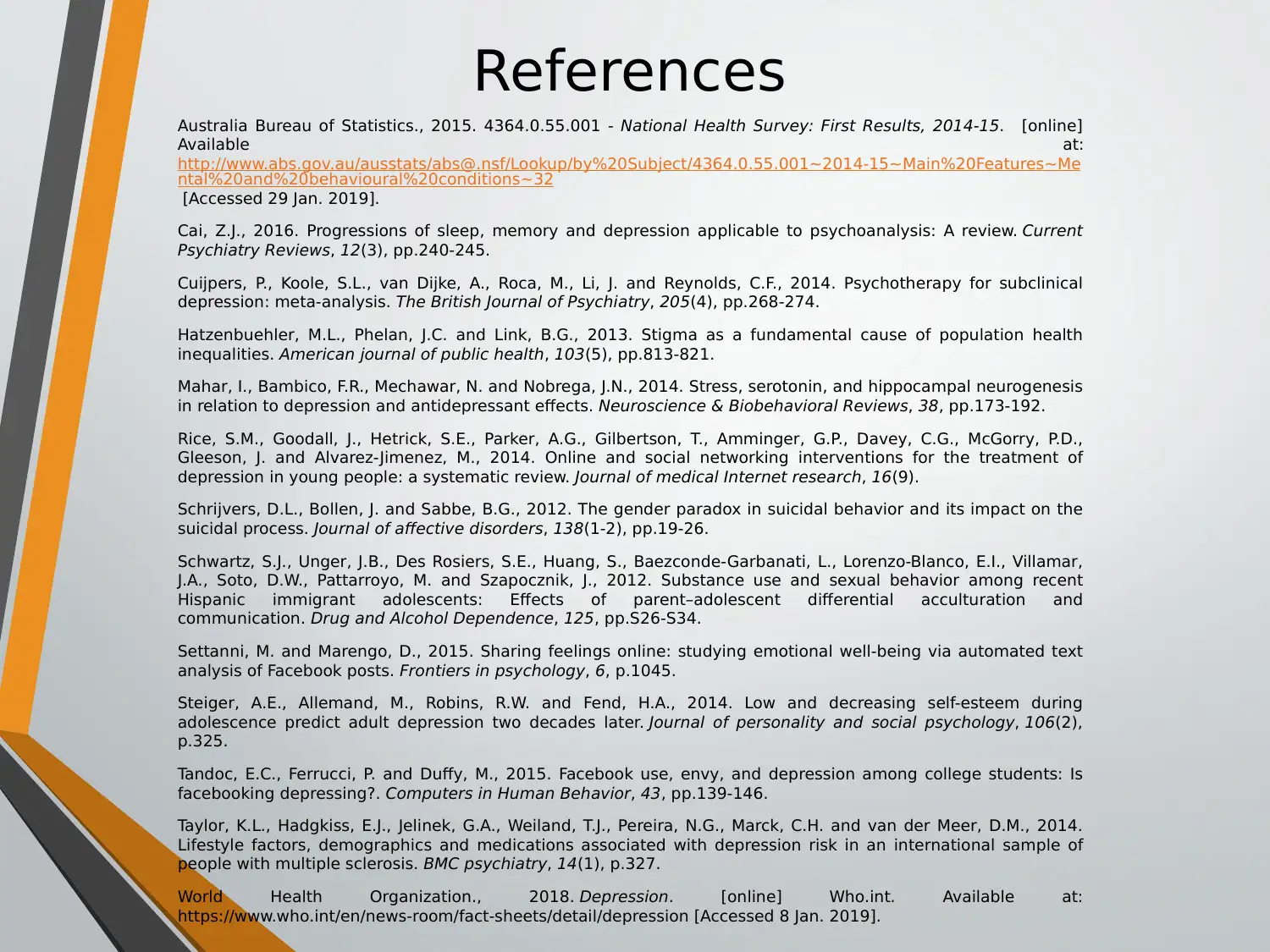
References
Australia Bureau of Statistics., 2015. 4364.0.55.001 - National Health Survey: First Results, 2014-15. [online]
Available at:
http://www.abs.gov.au/ausstats/abs@.nsf/Lookup/by%20Subject/4364.0.55.001~2014-15~Main%20Features~Me
ntal%20and%20behavioural%20conditions~32
[Accessed 29 Jan. 2019].
Cai, Z.J., 2016. Progressions of sleep, memory and depression applicable to psychoanalysis: A review. Current
Psychiatry Reviews, 12(3), pp.240-245.
Cuijpers, P., Koole, S.L., van Dijke, A., Roca, M., Li, J. and Reynolds, C.F., 2014. Psychotherapy for subclinical
depression: meta-analysis. The British Journal of Psychiatry, 205(4), pp.268-274.
Hatzenbuehler, M.L., Phelan, J.C. and Link, B.G., 2013. Stigma as a fundamental cause of population health
inequalities. American journal of public health, 103(5), pp.813-821.
Mahar, I., Bambico, F.R., Mechawar, N. and Nobrega, J.N., 2014. Stress, serotonin, and hippocampal neurogenesis
in relation to depression and antidepressant effects. Neuroscience & Biobehavioral Reviews, 38, pp.173-192.
Rice, S.M., Goodall, J., Hetrick, S.E., Parker, A.G., Gilbertson, T., Amminger, G.P., Davey, C.G., McGorry, P.D.,
Gleeson, J. and Alvarez-Jimenez, M., 2014. Online and social networking interventions for the treatment of
depression in young people: a systematic review. Journal of medical Internet research, 16(9).
Schrijvers, D.L., Bollen, J. and Sabbe, B.G., 2012. The gender paradox in suicidal behavior and its impact on the
suicidal process. Journal of affective disorders, 138(1-2), pp.19-26.
Schwartz, S.J., Unger, J.B., Des Rosiers, S.E., Huang, S., Baezconde-Garbanati, L., Lorenzo-Blanco, E.I., Villamar,
J.A., Soto, D.W., Pattarroyo, M. and Szapocznik, J., 2012. Substance use and sexual behavior among recent
Hispanic immigrant adolescents: Effects of parent–adolescent differential acculturation and
communication. Drug and Alcohol Dependence, 125, pp.S26-S34.
Settanni, M. and Marengo, D., 2015. Sharing feelings online: studying emotional well-being via automated text
analysis of Facebook posts. Frontiers in psychology, 6, p.1045.
Steiger, A.E., Allemand, M., Robins, R.W. and Fend, H.A., 2014. Low and decreasing self-esteem during
adolescence predict adult depression two decades later. Journal of personality and social psychology, 106(2),
p.325.
Tandoc, E.C., Ferrucci, P. and Duffy, M., 2015. Facebook use, envy, and depression among college students: Is
facebooking depressing?. Computers in Human Behavior, 43, pp.139-146.
Taylor, K.L., Hadgkiss, E.J., Jelinek, G.A., Weiland, T.J., Pereira, N.G., Marck, C.H. and van der Meer, D.M., 2014.
Lifestyle factors, demographics and medications associated with depression risk in an international sample of
people with multiple sclerosis. BMC psychiatry, 14(1), p.327.
World Health Organization., 2018. Depression. [online] Who.int. Available at:
https://www.who.int/en/news-room/fact-sheets/detail/depression [Accessed 8 Jan. 2019].
Australia Bureau of Statistics., 2015. 4364.0.55.001 - National Health Survey: First Results, 2014-15. [online]
Available at:
http://www.abs.gov.au/ausstats/abs@.nsf/Lookup/by%20Subject/4364.0.55.001~2014-15~Main%20Features~Me
ntal%20and%20behavioural%20conditions~32
[Accessed 29 Jan. 2019].
Cai, Z.J., 2016. Progressions of sleep, memory and depression applicable to psychoanalysis: A review. Current
Psychiatry Reviews, 12(3), pp.240-245.
Cuijpers, P., Koole, S.L., van Dijke, A., Roca, M., Li, J. and Reynolds, C.F., 2014. Psychotherapy for subclinical
depression: meta-analysis. The British Journal of Psychiatry, 205(4), pp.268-274.
Hatzenbuehler, M.L., Phelan, J.C. and Link, B.G., 2013. Stigma as a fundamental cause of population health
inequalities. American journal of public health, 103(5), pp.813-821.
Mahar, I., Bambico, F.R., Mechawar, N. and Nobrega, J.N., 2014. Stress, serotonin, and hippocampal neurogenesis
in relation to depression and antidepressant effects. Neuroscience & Biobehavioral Reviews, 38, pp.173-192.
Rice, S.M., Goodall, J., Hetrick, S.E., Parker, A.G., Gilbertson, T., Amminger, G.P., Davey, C.G., McGorry, P.D.,
Gleeson, J. and Alvarez-Jimenez, M., 2014. Online and social networking interventions for the treatment of
depression in young people: a systematic review. Journal of medical Internet research, 16(9).
Schrijvers, D.L., Bollen, J. and Sabbe, B.G., 2012. The gender paradox in suicidal behavior and its impact on the
suicidal process. Journal of affective disorders, 138(1-2), pp.19-26.
Schwartz, S.J., Unger, J.B., Des Rosiers, S.E., Huang, S., Baezconde-Garbanati, L., Lorenzo-Blanco, E.I., Villamar,
J.A., Soto, D.W., Pattarroyo, M. and Szapocznik, J., 2012. Substance use and sexual behavior among recent
Hispanic immigrant adolescents: Effects of parent–adolescent differential acculturation and
communication. Drug and Alcohol Dependence, 125, pp.S26-S34.
Settanni, M. and Marengo, D., 2015. Sharing feelings online: studying emotional well-being via automated text
analysis of Facebook posts. Frontiers in psychology, 6, p.1045.
Steiger, A.E., Allemand, M., Robins, R.W. and Fend, H.A., 2014. Low and decreasing self-esteem during
adolescence predict adult depression two decades later. Journal of personality and social psychology, 106(2),
p.325.
Tandoc, E.C., Ferrucci, P. and Duffy, M., 2015. Facebook use, envy, and depression among college students: Is
facebooking depressing?. Computers in Human Behavior, 43, pp.139-146.
Taylor, K.L., Hadgkiss, E.J., Jelinek, G.A., Weiland, T.J., Pereira, N.G., Marck, C.H. and van der Meer, D.M., 2014.
Lifestyle factors, demographics and medications associated with depression risk in an international sample of
people with multiple sclerosis. BMC psychiatry, 14(1), p.327.
World Health Organization., 2018. Depression. [online] Who.int. Available at:
https://www.who.int/en/news-room/fact-sheets/detail/depression [Accessed 8 Jan. 2019].

Thank you!
1 out of 16
Related Documents
Your All-in-One AI-Powered Toolkit for Academic Success.
+13062052269
info@desklib.com
Available 24*7 on WhatsApp / Email
![[object Object]](/_next/static/media/star-bottom.7253800d.svg)
Unlock your academic potential
© 2024 | Zucol Services PVT LTD | All rights reserved.





